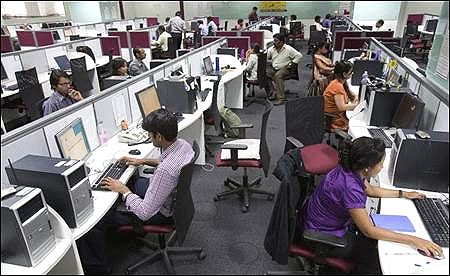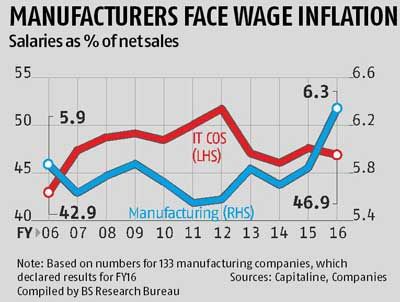
In the past five years, IT companies’ net sales grew faster than their salary bill, unlike manufacturing firms
Employee productivity growth at information technology services companies has been much better than manufacturing firms.
Going by 2015-16 data, salaries as a percentage of revenue have decreased for software services firms but increased for manufacturing companies over the past five years.
In the past five years, per-employee revenue for IT companies grew at 9 per cent each year, faster than the 8.4 per cent annual growth in salary cost per employee during the period.
This resulted in a steady decline in the wage ratio, to 47 per cent of revenue in FY16 from around 50 per cent in FY11.
For manufacturing companies, the trend is opposite.
The ratio of wages to revenues rose to 6.4 per cent in FY16 from 5.5 per cent in FY11.
In the past five years, the combined employee cost of manufacturing companies, in the Business Standard sample, more than doubled -- growing at a compound annual growth rate of 17.2 per cent.
Net sales grew at a lower pace of 14.1 per cent CAGR during the period.
The gap is likely to widen, as many large manufacturing companies in sectors that are badly affected by the economic slowdown such as metals, capital goods and other industrial commodities are yet to declare their FY16 results.
So far, the manufacturing sector has been able to absorb higher employee costs and lower employee productivity as commodity and energy prices are low.
In the past five years, the ratio of raw material to revenue declined by 1,200 basis points, to 42.7 per cent of net sales in FY16 from 55 per cent in FY11.
One basis point is one hundredth of a per cent.
The analysis is based on financial data of manufacturing and IT services companies, which have declared their FY16 results.
The sample includes only those companies that have comparable data for the past ten years.
The sample has 133 manufacturing companies and eight IT services companies.
 At the end of March 2016, eight top IT companies in the sample employed 871,000 people, up 8.7 per cent from the previous year.
At the end of March 2016, eight top IT companies in the sample employed 871,000 people, up 8.7 per cent from the previous year.
IT companies paid Rs 1.29 lakh crore or Rs 1.29 trillion by way of salary and wages in the previous financial year, translating into a per employee cost of around Rs 13.7 lakh or Rs 1.37 million a year, up 6.2 per cent over last financial year.
The salary bill for HCL Technologies is annualised based on their numbers for nine months ending March this year.
The company follows July to June calendar.
The comparable per employee data is not available for manufacturing companies as most companies do not publish their year-end headcount unlike IT companies.
Prior to FY11, the productivity situation was different.
Between FY06 and FY11, IT companies had witnessed salary inflation, leading to a decline in their employee productivity despite a high 24 per cent annual growth in their net sales.
But their salary and wages had grown faster at a CAGR of 25.4 per cent.
In the same period (FY06-FY11), manufacturing companies had reported a decline in their wage ratio as net sales had growth faster than wage costs during the period.
Net sales for manufacturing companies in the sample grew at a CAGR of 21.9 per cent, faster than the 21.2 per cent growth in the wage bill.
Analysts blame it on price deflation induced by a global slump in commodity prices.
“Lower commodity prices led to a decline in output prices in many sectors but companies couldn’t cut their employees’ salaries.
"This has created a wedge between revenue growth and wages,” says Dhananjay Sinha, head, institutional equity, Emkay Global Financial Services.
He expects the problem to disappear as rising commodity prices should increase net sales of manufacturing companies.
Economists, however, say it is a long-term issue, which is not going away soon.
“India’s labour productivity growth has fallen sharply even when measured at constant prices cancelling out the price impact of lower commodity prices.
"Longer and sustainable labour productivity growth may require fresh investment in new technologies and capital besides structural changes by the government,” says Devendra Pant, head-economist, India Ratings.
According to a study by India Ratings, the average labour productivity growth in India fell to 3.84 per cent during FY11-FY15 from a high growth of 9 per cent during the boom years of FY05-FY08.










